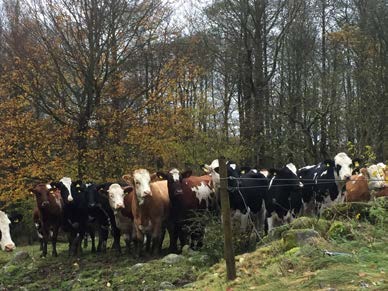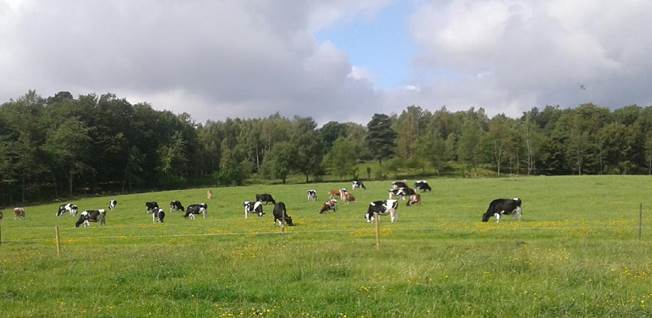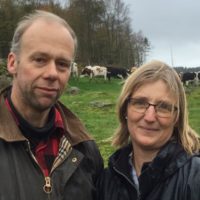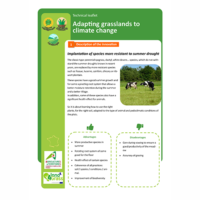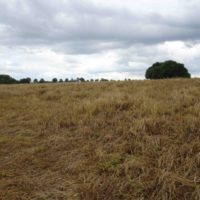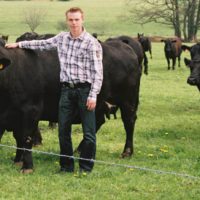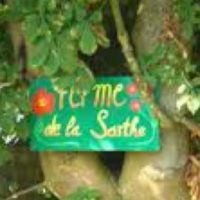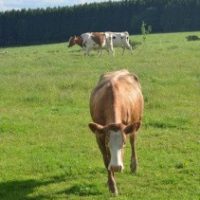Simple system for better rotational grazing for heifers and young steers
Farm: “Skogsgård”
Location: Halland, Sweden
Case study
 Simple system for better rotational grazing for heifers and young steers (.pdf)
Simple system for better rotational grazing for heifers and young steers (.pdf)
Description
Background
Skogsgård Farm, which is located in Getinge in south-west Sweden, has an organic dairy unit with 240 cows. The farm converted to organic in 1995 and since then it has refined its grazing system to get more milk and animal growth from its grassland. In the surrounding region there are many active farms and it is difficult to get arable land. When the farm needed more arable acreage 20 years ago, the only option was to lease land 25 km away, in an area where the plains landscape transitions to forest. The farms there are smaller, with a few dozen hectares of arable, permanent pasture and some forest. These farms tend to have stopped livestock production, but still want their fields kept open by grazing. Skogsgård Farm leases 30 ha of temporary grassland and semi-natural grassland in the area, which are grazed by the farm’s young stock. Day-to-day supervision of these animals is carried out by the nearby land owners, while transport of animals and other management of the land are carried out by Skogsgård Farm itself.
Detailed description
The dairy cows have a well-managed paddock system that gives large yield and high quality. This requires the cows to be moved once or twice a day. For the young stock grazing the leased fields farther away, a simpler system that still gives good quality and quantity is applied. The young stock were originally kept on 2–3 paddocks and moved between these, but this has now been increased to four paddocks. These animals graze a paddock for a week before being moved to the next, so there is a three-week interval between grazings on each paddock. The optimal approach for both quality and quantity is to graze the grass at the three-leaf stage. In summer, it takes around a week for each leaf to develop, so the growth rhythm of the grass matches the paddock rotation. In spring, when growth is fast and leaf development is faster than a leaf a week, it is difficult for the grazing animals to keep up. Half of the young stock are let out on grazing early, in April, when growth is slow. If necessary, they receive a supplement of round bale silage. The animals are happier with such supplementary feeding in spring than in autumn. The animals are moved to a new paddock every week. The remaining animals are let out around ‘magic day’, the time when their feed requirements match the growth rate of the grassland. After this, the animals are moved between the four paddocks on a weekly basis. When the grass is growing too fast for the young stock to keep up, different measures are undertaken. One is to introduce more animals to increase the grazing pressure. Another is to set aside a paddock for forage harvesting. This forage can be used for supplementary feeding at a later date. When the grazing pressure becomes too high, some animals can be taken off. In August, grass growth usually starts to decline and then around half the animals are removed and put to grazing regrowth or forage crops such as stubble turnips, fodder rape or swedes.
The animals are supplied with water by a pipeline at a point when several paddocks meet. This ‘square’ has several entrances to the different paddocks, to reduce trampling damage.
Results
By increasing the number of paddocks and improving the infrastructure, Skogsgård Farm has managed to increase its grassland utilisation with a reasonable labour input, despite the grazing land being far from the main farm. It is now possible to keep more young stock on the same area and still get better growth per animal. Compensatory growth means that these animals can increase in weight when they are moved to a new paddock. It is now easier to see when a paddock is fully grazed, since the young stock are kept on a smaller area. The more intensive grazing has also affected to composition of the sward. In some fields that are not grazed sufficiently well, soft-rush tends to grow in wet patches. When the young animals graze hard they also graze the soft-rush and after only a year there is a marked reduction in its incidence. The same applies to dock plants. This version of paddock grazing increases the yield and quality of the grass and reduces the labour requirement for moving animals.
Adoption criteria
This system works well for those wishing to change from continuous grazing to paddock grazing or wishing to increase the intensity and structure of their paddock grazing. It is a way to make grass last longer. The lower intensity compared with conventional rotational grazing means that it is suitable for those farmers who do not wish to move their animals as often. The paddocks also lead to more complete grazing and less need for mowing, and therefore better managed grazing. With the one-week system, it is easier to monitor grass growth rate by visual observations and take action, e.g. alter the grazing intensity or harvest the forage.
Future prospects
The grassland in Sjöred, where the young stock is kept, is mainly located on very light soils that are susceptible to drought. However, there is a lot of rainfall in the area so the grass often copes very well. Year 2018 was an extremely hot, dry year, so the grassland scorched and became completely brown. Most of the young stock had to be moved to other fields. This led to an idea that can be tested: by increasing the number of paddocks from four to five, it may be possible to create a buffer of grazing. In spring and early summer the young stock could be moved every 5 days. This would mean grazing at 2.5 leaf stage and getting a more immature forage with higher quality. If it appears that the animals cannot keep up with grass growth, they can miss out a paddock, which is left ungrazed. The quality of the grass will decline in that paddock, but it can be strip-grazed in the event of drought or later in the year when grass growth is declining. The extra forage will then extend the number of rotation days and, hopefully, the number of grazing days. Letting the grass heading will also result in natural re-seeding and restoration of the sward. Different paddocks can be set aside in different years. This system would also work well for semi-natural grassland with high nature values.
Additional information
| Farming system | organic farming |
|---|---|
| Domains of innovation | grazing management system |
| Main types of animal | beef cattle, dairy cattle |
| Country | Sweden |
| Product type | Case study |
| Language | English |
| Author | Anna Carlsson |

